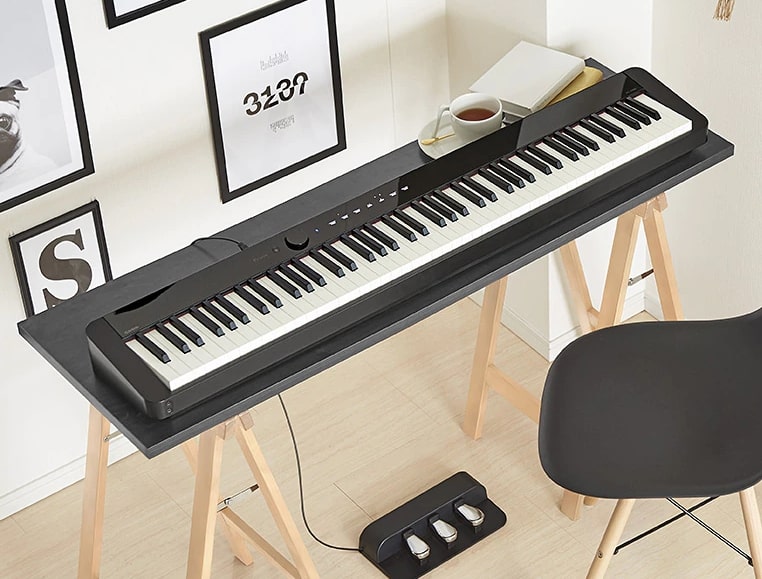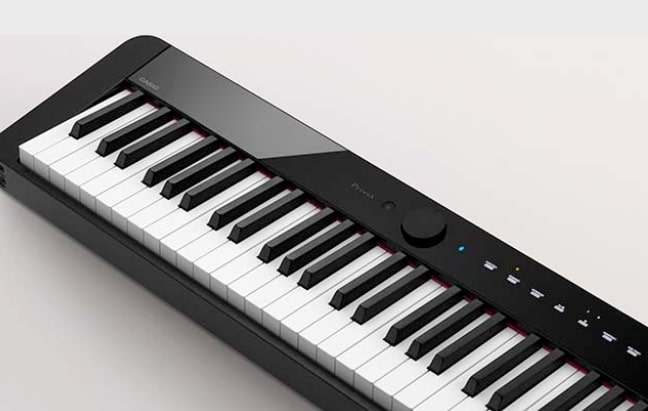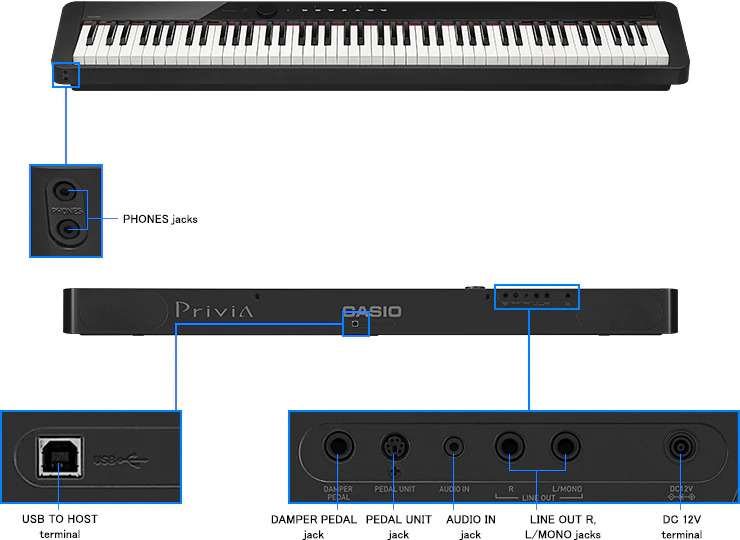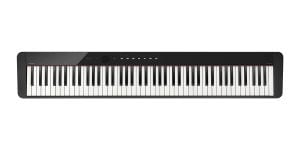The Privia series of pianos from Casio proves the point that it can manufacture the best instruments on par with big brands like Roland, Yamaha, etc. This Privia series from Casio is known for its lifelike sound, excellent playability, authenticity, etc., and is all set to bring in the best of technology for the musical life of its clients. With each updating instrument in this series, we can say that the brand is improving and evolving consistently over the years. Let us discuss the most advanced, affordable, and best-sounding piano from the Privia series, the PX-S1000 here with a sneak peek of its specifications and special features.
Casio PX-S1000 Digital Piano Review 2024
Quick Opinion by Larry
Casio PX-S1000 is an ideal choice for someone looking to improve as a pianist as the sound quality of this piano is just amazing, although the internal speakers should have been better. But considering the price, its value for money, a perfect piano for home.
Pros & Cons of Casio PX-S1000
What’s Best in Casio PX-S1000?
- Unique design with excellent functionalities
- A very compact piano that can function with 6 AA batteries
- It is possible to adjust a number of parameters as far as the piano nuances are concerned
- The Chordana app helps amateurs with piano tutorials and to control some features of the piano through its graphical user interface.
- Bluetooth connectivity
What’s Lacking in Casio PX-S1000?
- The pianist may have to stretch their fingers to play in between the keys owning to their short pivot length.
- Its Flossy finish can attract fingerprints
- Lacks screen and Bluetooth MIDI supports
- No possibility to port songs to an external device.
Overview of the Casio PX-S1000
| Number of Keys | 88 |
| Piano Sound | Multi-dimensional Morphing AiR Sound Source |
| Weight | 25 lbs |
| Keyboard Type | Smart Scaled Hammer Action Keyboard |
| Sounds | 18 |
| Polyphony | 192 |
The PX-S1000 is the perfect combination of innovation and playability that makes it something special more than ordinary pianos. One outstanding feature of this series is that it is not an improvisation over its predecessors and is entirely fresh. Its unique specifications are.
- An extremely lightweight and portable keyboard that weighs only 11 kg.
- Integration of Celviano series for better acoustic simulation
- Smart scaled hammer action keyboard with 88 full weighted keys
- AiR sound source with multi-dimensional morphing
- 18 instrument sounds with 60 built-in songs
- 192 note polyphony with two play modes
- 2 track MIDI recorder
- Adjustable acoustic simulator with damper noise and hammer response
- About 17 temperament options
- 2 x 8W oval speakers
- Excellent connectivity features
The First Look of the Casio PX-S1000
The PX-S1000 belongs to the Slim category of the Casio series and we should accept that this piano is seriously slim and compact, with its dimensions being 52 x 9.1 x 4 inches. It is the slimmest piano in the world, without any second thought. You can move it easily in your home and can carry it for all of your stage shows without any hassle. But what amazes most pianists is that the S1000 packs a lot of impressive features within its small enclosure.

In contrast to other pianos that are available in the same price range, the PX-S1000 features a glossy plastic finish and looks very modern with fingerprint-resistant technology. Its glossy reflective finish is pretty much a striking feature of this piano, which you cannot find elsewhere.
Its front panel is simple and elegant. You will see only the volume knob, the power button, and the Privia logo. All other control buttons are touch-based; they will light up only when you turn on the piano. These controls are visible even at low light conditions and are marked clearly. The keyboard comes in black and white colors. As a limited edition offer, the PX-S1000 is now available in red color as well.
The controls on the piano make use of capacitive technology and the pianist has to touch them with bare hands to activate them, just like how you use your touch phones. You also will have to use a number of key combinations to access different functions of the piano. Though there is no screen to display the controls, the piano features a convenient feedback sound, that plays every single time you change its settings.
And unlike most other digital and stage pianos, the S1000 can also run on 6 AA-size batteries. This is an added advantage for stage performers as the batteries can light up the piano for four hours of non-stop playing. The playing time can also be enhanced by using alkaline batteries.
The Keyboard of the Casio PX-S1000
As the other model pianos from Casio make use of the Tri-sensor hammer action keyboard, our PX-S1000 makes use of smart scaled hammer action keys, perhaps to accommodate its slim chassis. It translates that you can enjoy two sensor actions with the keys and there is no three-sensor mode here. But the two-sensor play mode also stays excellent and is indeed a software-based solution that determines the depth of the key presses.

The keys are purely made of plastic and have ebony and ivory simulations to offer them a textured feel. The subtle grip on each of the keys ensures that you will not slip off while playing them. It also encompasses new actions, such as the ‘silent mechanism’ and ‘less bounciness’ that makes it the quietest keyboard in the series.
But some pianist feels that the key action is quite smaller and also the pivot length, perhaps to accommodate the keys better into a smaller body. Thus the piano could be a little harder to play and it could be difficult to control the keys at the back. The keyboard has five levels of touch sensitivity spanning from light to heavy, along with an Off option, thus the harder you hit the key, the louder its sound.
The Sound System of the PX-S1000
Casio has taken a lot of steps to make the S1000 sound new. It has swapped out a few sounds from its previous pianos and has also updated its sample sets. A number of new sounds have been added to the existing panel of sounds, with clear and definitive improvement. You get 18 sounds in total from that grand pianos, electric pianos, upright pianos, organs, strings, electric bass, vibraphone, and harpsichord.
The piano sounds are sampled from the concert grand piano with excellent tones, sounding similar to the grand acoustic pianos along with the jazz pianos and the mellow grand pianos. The AiR modeling technologies help the pianist to sculpt their music by tweaking its different parameters. These parameters include the damper resonance, string resonance, key on and off action noise, damper pedal noise, etc. All of these temperaments are available in four different intensities starting from soft to loud. The piano definitely sounds clean and realistic, incorporating all such subtle details.
There are three built-in sound effects that help the pianist modify the tunes according to their taste. The hall reverb and the surround sound models can be tweaked from 0 to 42 to reach algorithms with variable intensity. The four different algorithms that you can reach in this piano are the opera hall, standard concert hall, British outdoor stadium hall, Berlin arena hall, etc.
There is also a surround sound feature that comes in two variations a chorus and a brilliance effect. The chorus has four different intensities starting from light chorus to full flanger effect. The brilliance mode helps the pianist to modify certain sounds, to let them sound too bright. The S1000 has a beautiful 192-note polyphony which is good enough to play any song in any genre.
This Casio has two built-in 8W speakers with excellent amplification, good enough to fill a medium-sized room with awesome music. The speakers are at the rear, and if you face it against the wall, you can benefit from a wide soundscape.
Play Modes and Recording Capability
The PX-S1000 can play in three play modes, namely the layer mode, split mode, and the Duo mode. The layer mode allows the pianist to play two sounds of two different instruments simultaneously, layered on top of each other.
The duet play mode splits the piano into two tiny instruments and enables two people to play notes on it simultaneously, good enough for teachers and students to share their lessons. The split mode divides the piano at a specific point to play two different instruments separately.
Coming to the playback and recording feature, the piano comes with 60 built-in songs from different genres for practice. The record button on the touch panel helps you to record your own song as well. You can record songs in MIDI format but you cannot port them to a smart device or a USB drive. But you can load up to 10 songs from the smart device to the piano with a USB cable.
Also Read: Best Budget Digital Pianos Under $500
Casio PX-S1000 Connectivity Features
Some best connectivity options that make this an excellent stage use piano are,
- Stereo jacks for headphones
- Audio in jack to connect phones and music players for song playback
- Stereo line out jack to connect with an external audio interface.
- USB to host port to connect the piano to supported devices and Chordana app.
- Two pedal jacks to connect with the damper Pedal and also with the optional three-pedal setups.

Alternatives of Casio PX-S1000
Here are the top alternatives of Casio PX-S1000 that you can choose in case you have a limited budget of $700 to $1500.
- Yamaha P125 Digital Piano
- Kawai ES110 Piano
- Yamaha YPG-535 Portable Piano
- Casio PX-S3000 Digital Piano
- Casio PX-870 Piano
Final Verdict on Casio PX-S1000
The Casio PX-S1000 is a very innovative instrument that packs a number of unique features in its compact chassis. It offers a number of satisfying features at a comfortable price and its improvements over its predecessors are commendable. It also adjusts pretty well to the preferences of pianists and is thus ideal for both beginners and professional pianists.

